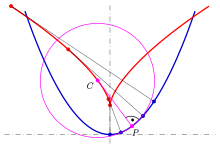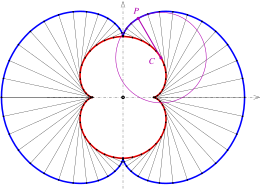Evolute


In thedifferential geometry of curves,theevoluteof acurveis thelocusof all itscenters of curvature.That is to say that when the center of curvature of each point on a curve is drawn, the resultant shape will be the evolute of that curve. The evolute of a circle is therefore a single point at its center.[1]Equivalently, an evolute is theenvelopeof thenormalsto a curve.
The evolute of a curve, a surface, or more generally asubmanifold,is thecausticof the normal map. LetMbe a smooth, regular submanifold inRn.For each pointpinMand each vectorv,based atpand normal toM,we associate the pointp+v.This defines aLagrangian map,called the normal map. The caustic of the normal map is the evolute ofM.[2]
Evolutes are closely connected toinvolutes:A curve is the evolute of any of its involutes.
History
[edit]Apollonius(c.200 BC) discussed evolutes in Book V of hisConics.However,Huygensis sometimes credited with being the first to study them (1673). Huygens formulated his theory of evolutes sometime around 1659 to help solve the problem of finding thetautochrone curve,which in turn helped him construct an isochronous pendulum. This was because the tautochrone curve is acycloid,and the cycloid has the unique property that its evolute is also a cycloid. The theory of evolutes, in fact, allowed Huygens to achieve many results that would later be found using calculus.[3]
Evolute of a parametric curve
[edit]Ifis the parametric representation of aregular curvein the plane with its curvature nowhere 0 andits curvature radius andthe unit normal pointing to the curvature center, then describes theevoluteof the given curve.
Forandone gets and
Properties of the evolute
[edit]
In order to derive properties of a regular curve it is advantageous to use thearc lengthof the given curve as its parameter, because ofand(seeFrenet–Serret formulas). Hence the tangent vector of the evoluteis: From this equation one gets the following properties of the evolute:
- At points withthe evolute isnot regular.That means: at points with maximal or minimal curvature (verticesof the given curve) the evolute hascusps.(See the diagrams of the evolutes of the parabola, the ellipse, the cycloid and the nephroid.)
- For any arc of the evolute that does not include a cusp, the length of the arc equals the difference between the radii of curvature at its endpoints. This fact leads to an easy proof of theTait–Kneser theoremon nesting ofosculating circles.[4]
- The normals of the given curve at points of nonzero curvature are tangents to the evolute, and the normals of the curve at points of zero curvature are asymptotes to the evolute. Hence: the evolute is theenvelope of the normalsof the given curve.
- At sections of the curve withorthe curve is aninvoluteof its evolute. (In the diagram: The blue parabola is an involute of the red semicubic parabola, which is actually the evolute of the blue parabola.)
Proofof the last property:
Let beat the section of consideration. Aninvoluteof the evolute can be described as follows:
whereis a fixed string extension (seeInvolute of a parameterized curve).
Withandone gets
That means: For the string extensionthe given curve is reproduced.
- Parallel curveshave the same evolute.
Proof:A parallel curve with distanceoff the given curve has the parametric representationand the radius of curvature(seeparallel curve). Hence the evolute of the parallel curve is
Examples
[edit]Evolute of a parabola
[edit]For the parabola with the parametric representationone gets from the formulae above the equations: which describes asemicubic parabola

Evolute of an ellipse
[edit]For the ellipse with the parametric representationone gets:[5] These are the equations of a non symmetricastroid. Eliminating parameterleads to the implicit representation

Evolute of a cycloid
[edit]For thecycloidwith the parametric representationthe evolute will be:[6] which describes a transposed replica of itself.

Evolute of log-aesthetic curves
[edit]The evolute of alog-aesthetic curveis another log-aesthetic curve.[7]One instance of this relation is that the evolute of anEuler spiralis a spiral withCesàro equation.[8]
Evolutes of some curves
[edit]The evolute
- of aparabolais a semicubic parabola (see above),
- of anellipseis a non symmetric astroid (see above),
- of alineis anideal point,
- of anephroidis a nephroid (half as large, see diagram),
- of anastroidis an astroid (twice as large),
- of acardioidis a cardioid (one third as large),
- of acircleis its center,
- of adeltoidis a deltoid (three times as large),
- of acycloidis a congruent cycloid,
- of alogarithmic spiralis the same logarithmic spiral,
- of atractrixis a catenary.
Radial curve
[edit]A curve with a similar definition is theradialof a given curve. For each point on the curve take the vector from the point to the center of curvature and translate it so that it begins at the origin. Then the locus of points at the end of such vectors is called the radial of the curve. The equation for the radial is obtained by removing thexandyterms from the equation of the evolute. This produces
References
[edit]- ^Weisstein, Eric W."Circle Evolute".MathWorld.
- ^Arnold, V. I.; Varchenko, A. N.; Gusein-Zade, S. M. (1985).The Classification of Critical Points, Caustics and Wave Fronts: Singularities of Differentiable Maps, Vol 1.Birkhäuser.ISBN0-8176-3187-9.
- ^Yoder, Joella G.(2004).Unrolling Time: Christiaan Huygens and the Mathematization of Nature.Cambridge University Press.
- ^Ghys, Étienne;Tabachnikov, Sergei;Timorin, Vladlen (2013). "Osculating curves: around the Tait-Kneser theorem".The Mathematical Intelligencer.35(1): 61–66.arXiv:1207.5662.doi:10.1007/s00283-012-9336-6.MR3041992.
- ^R.Courant:Vorlesungen über Differential- und Integralrechnung.Band 1, Springer-Verlag, 1955, S. 268.
- ^Weisstein, Eric W."Cycloid Evolute".MathWorld.
- ^Yoshida, N., & Saito, T. (2012). "The Evolutes of Log-Aesthetic Planar Curves and the Drawable Boundaries of the Curve Segments".Computer-Aided Design and Applications.9(5): 721–731.doi:10.3722/cadaps.2012.721-731.
{{cite journal}}:CS1 maint: multiple names: authors list (link) - ^"Evolute of the Euler spiral".Linebender wiki.2024-03-11.
- Weisstein, Eric W."Evolute".MathWorld.
- Sokolov, D.D. (2001) [1994],"Evolute",Encyclopedia of Mathematics,EMS Press
- Yates, R. C.:A Handbook on Curves and Their Properties,J. W. Edwards (1952), "Evolutes." pp. 86ff
- Evolute on 2d curves.

![{\displaystyle {\vec {x}}={\vec {c}}(t),\;t\in [t_{1},t_{2}]}](https://wikimedia.org/api/rest_v1/media/math/render/svg/c39b96578c926c9cfc44b8bab1621e67aac866f9)




































